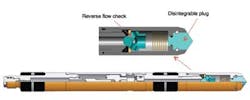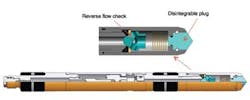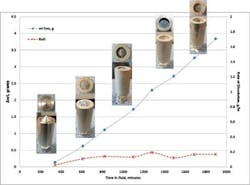Smart valve system provides interventionless completions
Technology applied for gas lift offshore Thailand
Zhiyue Xu
B. M. Richard
James H. Kritzler
Baker Hughes
The artificial lift method of gas lift is an increasingly popular means of boosting production from wells with lagging reservoir pressure. The method injects a compressed gas into well annulus between the production tubing and casing. Tubing and casing pressures cause the valve to open and close, which introduces the gas into the produced fluid in the tubing. The injected gas aerates the fluid to reduce its density, thus allowing the reservoir pressure to push the mixture of produced fluids and gas up to the surface.
Multiple gas lift valves are typically installed in a well to ensure optimal production as the well's pressures, fluid compositions, and productivity change. In a representative four-valve gas lift system, each gas lift valve is installed in a side packet mandrel (SPM), which in turn is placed on theproduction tubing of a gas lift well. Gas lift valves are designed for installation and removal by wireline while the mandrel remains in the well, which eliminates the need to pull the tubing to repair or replace the valve (as is required in a conventional gas lift mandrel).
After initial installation of a live gas lift valve system, pressurization is required to confirm the pressure integrity of the tubing or annulus, set a hydraulic packer, activate an isolation device or run cement through completion. Any unplanned pressure reversal or cement debris may damage the live gas lift valve, resulting in costly well completion failures.
Dummy valves are commonly deployed as a means of avoiding damage to a live valve. These higher pressure-rated dummy valves are loaded in the SPM to isolate the annulus from the tubing during initial pressurization or the cementing-through operation. Should the well then require gas lift to unload the completion fluid or to get the well flowing, the dummy valves must be replaced with the live gas lift string via a wireline intervention. Not only can an intervention be a time-consuming process that poses risks to the existing well infrastructure, but it also delays the onset of production. Slickline crews are a finite and in-demand resource, and sometimes cannot be scheduled for a valve change-out project for many weeks. Some industry estimates suggest that waiting up to one month for a valve change out on a 20-well platform translates to as much as 100,000 bbl in lost production.
A nanostructured solution
The industry need for lower risk, interventionless alternatives to gas lift valve changeouts prompted Baker Hughes to develop a smart gas lift valve that could function as a dummy valve during completion operations and then convert to a live valve, without the need for a well intervention. This is achieved through the use of a disintegrable barrier or plug made of nanostructured composite material. This plug provides the necessary annulus isolation while performing completions work, and then disintegrates in the presence of brine during the cleanup process, thus increasing completion operation efficiency of offshore wells. The nanostructured composite plug is rated for high pressures, chemically resistant to drilling mud, slightly reactive with fresh water, and disintegrates within 12 to 50 hours in salt water.
The smart material used to make the time-controlled barrier is a nanostructured powder metallurgy composite manufactured by consolidating reactive metal powders coated with metallic and/or ceramic reinforcements. Material composition and structure can be engineered at the micro- or nanoscale to vary the material strength and disintegration rate. The combination of high-strength and controllable disintegration rate is accomplished through engineered nanostructures between metallic grains. These grains become activation points for dissolution that can be triggered on demand. The nanostructures also act as strengtheners, which yield a composite material with high strength and toughness.
Typical concentrations of ions present in seawater, completion brines, formation fluids, or remediation acids, as well as typical downhole temperatures of 120°F (49°C) or higher, trigger a predictable and homogeneous dissolution of the nanostructured composite.
The nanostructured composite was then incorporated into a smart gas lift valve design in the form of a time-controlled disintegrable barrier or plug. Assembled in the nose section of the valve, the disintegrable barrier replaces the two nose holes in a standard valve design, while retaining the same geometry, cone-shaped nose tip and the reverse flow check dart design of a standard gas lift valve.
Prior to introducing a smart gas lift valve into the field, extensive laboratory testing was performed to determine the in-field operating parameters within which the valve would safely and reliably operate. Disintegration tests were conducted in different fluids at 200°F (93°C) and 1 atmosphere pressure. The results of these tests showed that the composite material is resistant to oil-based drilling mud, slightly reactive with fresh water or cement, and rapidly disintegrates in 3% KCl brine or seawater. This makes it ideal for offshore gas lift valve applications.
In another series of disintegration tests, the time-controlled disintegrable plug was assembled in a fixture that duplicated the standard gas lift valve nose design and was submerged in seawater at 275°F (135°C) and 500 psi (34.5 bar). The mass loss of the plug due to the disintegration reaction with seawater was measured at various time intervals. The test was stopped at 31.6 hours, when the plug lost most of its fluid-sealing dimension. The plug disintegrated uniformly throughout the test period at an average rate of 0.18 g/hour. The test verified that the plug design could meet the required 12-to-50 hour disintegration/conversion time for the dummy valve to become a live valve for gas lift.
Field trial in Thailand
In the Gulf of Thailand's Platong field, located 245 km (152 mi) east of mainland Thailand, the number of wells on gas-lifted production has gradually increased from 10% in June 2008 to more than 50% of current total field production. A major driver for this increased usage of gas lift is the reduced cost of installation. For example, in a monobore completion (a process in which a single production tubing size is used from the pay zone all the way to the surface of the well), the total cost of a one-trip cement through completion with gas lift is $1.67 million. This is a one-third reduction when compared to the $2.50 million cost of a conventional completion with casing and a separate upper and lower completion.
In a one-trip monobore gas lift completion, operators installed SPMs with the conventional live orifice or gas lift valves in the production tubing to prepare the wells for gas lift. Multiple slickline trips were necessary and costly completion failures occurred, including flow cutting of the reverse flow check valve during an unplanned pressure reversal. The failures occurred because the live gas lift valves were unable to hold the pressure as well as dummy valves while pumping cement through the SPM or activating the hydraulic packer.
The operator called Baker Hughes to install its time-controlled disintegrable plugs as part of a smart gas lift valve solution. The smart valves were installed in the SPMs prior to running the SPMs downhole, and then performed precisely as designed. The nanocomposite temporary dummy valves successfully isolated the annulus from the tubing and provided a proper pressure seal time for cementing and pressure testing operations to be completed. The plugs then disintegrated in brine during the cleanup process, converting the system to live valves for gas lift. The use of smart gas lift valves eliminated multiple slickline trips or well interventions after completion, saved service costs, and reduced health, safety, and environment risks.
The major benefit of the new gas lift technology was the immediate recovery of oil and an earlier return on investment, as time delay waiting for slickline service was eliminated. Because of the success of the smart gas lift valves with time-controlled disintegrable plugs, the operator requested the smart gas lift valves for all future projects in the Gulf of Thailand.
Acknowledgment
Based on a paper presented at the SPE Deepwater Drilling and Completions Conference, held Sept. 10-11, 2014, in Galveston, Texas.



